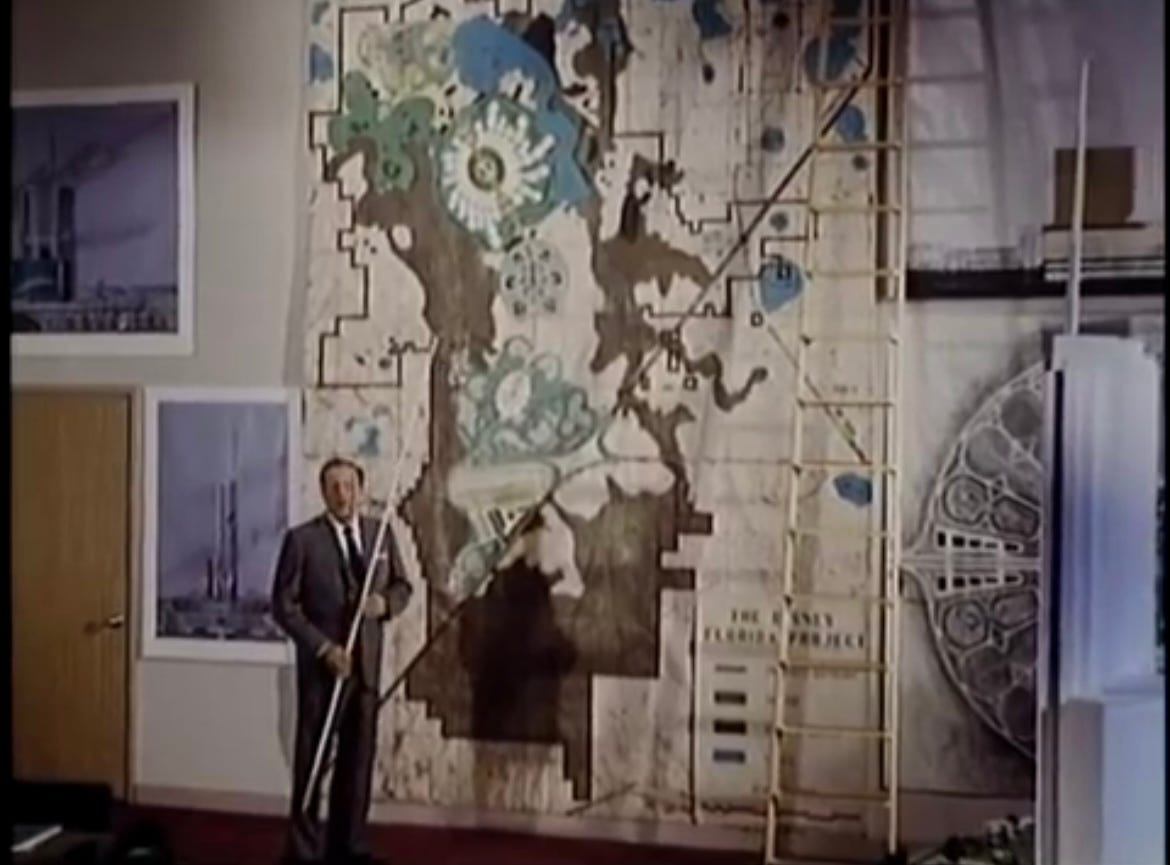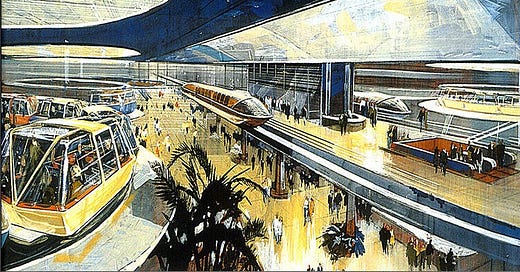This newsletter aims to separate the signal from the noise for making money in all things sustainable transportation: Electrification, mode shift, active and public transit, and mobility aggregation, across both people and goods movement.
A new episode of the Cities First podcast is now live, with guest Roger Spitz. Also, my episode of the EVs for Everyone podcast went live on the topic of “The EV Affordability Equation.” And last week I got to serve as a judge on an episode of The Startup Tank: Climate Investor Pitch Show.
This week’s Deep Dive is on Disney’s EPCOT. Was it Walt’s great unfinished masterpiece? Submit startups & ideas for the newsletter here.
🌱STARTUP WATCH: Sustainable mobility startups (pre-seed or seed) to keep an eye on
Blaze Energy (Colorado, USA): Turning liquid ammonia into tunable ammonia/hydrogen drop-in fuel blends
Carbon Centrum (Norway): Software to autonomously track individual CO2 footprints
PragmaCharge (United Kingdom): Heavy-duty EV fleet management as a service
Roil Network (New York, USA): Consumer software for incentivizing smart changing/demand response
Rove Charging (California, USA): Full-service EV charging center network
Scope Zero (California, USA): Employee carbon savings account as an HR benefit
Spark e-Fuels (Germany): Sustainable aviation fuels derived from renewables and electrolysis
💰FUNDING: Capital raises from startups previously featured in Startup Watch
Elvah (Vol 7) was acquired by E.ON. This is the 6th exit in the database
MobiQu (Vol 43) raised a pre-seed round (amount undisclosed) from Fark Labs and Mene Health Group
Gage Zero (Vol 51) signed up for upwards of $300M in project finance from Arc Financial and others
Crux (Vol 53) raised an additional $4.25M for its seed round from Ardent Venture Partners, LS Power, and Ørsted
Reminder: The startup data set is open, for free to subscribers. If you’re a subscriber interested in accessing the Airtable with all the raw data on 400+ companies, please let me know.
📰QUICK HITS: Notable news from the last two weeks
👩🏽⚖️Government, Policies & Cities
🇮🇩 Jakarta’s high-speed rail system is entering the testing phase. This would make Indonesia the first in Southeast Asia with high-speed rail.
🗼Paris Mayor Anne Hidalgo claims that car traffic in the city has decreased by 40%, and pollution by 45% over the last decade. Hidalgo will be remembered for rewiring the transit of a very old city
💃🏽 LA City Council is moving ahead with a plan to pilot a Barcelona-style superblock program. Barcelona’s superblocks continue to capture the imagination of cities around the world.
⚖️ A California bill to force major businesses to disclose Scope 3 emissions is moving forward. Having a state economy roughly the size of Germany gives California the ability to rival Washington, D.C. for policy leadership in the US.
🧐 In New York state, Assembly Speaker Carl Heastie torpedoed a law to let NYC set its own speed limits despite clear legislative support, citing concerns about e-bikes and speed bumps. E-bikes are involved in less than 4% of pedestrian collisions.
🚉 New York Governor Kathy Hochul is moving forward with Penn Station renovation plans, without the accompanying office tower project. Keep an eye out for whether Madison Square Garden is forced to move to help Penn Station thrive.
🇪🇸 Spain will offer a tax break to EV buyers. Spain is a laggard in EV sales, falling behind other large EU markets and even behind smaller markets like Switzerland, Austria, and Sweden.
🚢 European nations are building global momentum for a carbon tax on maritime shipping. Key will be getting the US and China to go along.
🥊 Tensions are heating up between Germany and France over Chinese EVs. Time will tell whether Germany Inc’s reliance on China for profits is more of a weakness or more of a strength.
👩🏻🔧 The United Auto Workers is withholding an endorsement of Biden’s 2024 campaign on EV fears. Much of the manufacturing plans spurred by the Inflation Reduction Act benefit has gone to red states where the UAW doesn’t represent labor.
🔬Markets & Research
📈 The Green Finance Institute studied charger utilization across the UK. Utilization rates are growing fastest at higher-speed (100kW+) chargers.
⛏️ Transport and the Environment (T&E) weighed in on the European Commission’s draft Critical Raw Minerals Act. Key for T&E is strengthening Europe’s downstream recycling capability.
🏷️ Cox Automotive published its first half of 2023 automotive report. Cox estimates that this is the first year that new EV sales surpass 1 million units.
🔌 A new study from the National Renewable Energy Lab (NREL) estimates the demand for the US EV charging market in 2030. This is a robust study, but it ignores mobile and semi-fixed charging as batteries play a bigger and bigger role in the network.
🔋 NREL also updated its electricity Annual Technology Baseline (ATB) dataset. A key trend to look for is the continued decline in battery costs and their growing role in supporting intermittent renewables like solar and wind.
🚙Researchers at Harvard’s Kennedy School peg the government’s cost of supporting private driving at $14,000 per taxpayer. Per the study, more than 50% of private driving costs are covered by the government, not the individual.
👷🏽♀️ The US Department of Energy’s annual work survey showed that energy jobs, and in particular green energy jobs, are outpacing overall national job growth. There’s still valid concern about whether the US has enough skilled blue-collar labor to handle the energy transition.
🏭 Corporates & Later Stage
🤝 As expected, everyone else is joining the Tesla charging standard in North America, including Volvo cars, Rivian, VW’s Electrify America unit, Washington state, and Texas. The Deep Dive in Vol 57 outlines why everyone will eventually join.
🪖 Swiss food giant Nestlé is walking away from carbon-offsets in favor of driving down carbon emissions in its supply chain. Anti-environmentalists can cite this as evidence of walking back ESG ambitions while pro-environmentalists can applaud the pivot away from dubious offsets towards doing the hard work.
💰 Ford got a $9B loan from the US Dept of Energy for its 3 US battery plants with SK On. That nets out to about 80% of the project cost.
💧In Canada, private rail operator Réseau Charlevoix is demonstrating a hydrogen-powered train from French giant Alstom. Alstom hopes to prove that hydrogen can work in low-population-density, long-distance environments prevalent in much of North America.
⛽️ Boeing has launched a sustainable aviation fuels (SAF) dashboard to track major industry projects. In the most developed region for SAF, North America, the total of projected SAF capacity only amounts to 8% of jet fuel consumption.
🐣 Startups & Early Stage
🍃Car subscription companies like Go are crumbling under high-interest rates. It’s a tough business model even in good times.
🚁 Joby got FAA permission to test the factory-built version of its electric air taxi. The battles for the skies haven’t even begun.
⚰️ EV truck maker Lordstown entered bankruptcy. Foxconn has already claimed the only asset of any likely value - the factory. For more on Foxconn’s plans, see Vol 47.
🫥 Autonomous trucking startup TuSimple may leave the US market. The company’s China links make it all the harder in an era of China-US decoupling.
💡Rivian acquired Iternio, maker of the ABetterRouteplanner EV app. Some echoes of EVgo’s acquisition of PlugShare in 2021.
DEEP DIVE: Was EPCOT the Great Unfinished Masterpiece of Walt Disney?
If you’ve ever visited Walt Disney World in Florida, you may think that EPCOT is simply a place for a deranged global drinking game. But the actual EPCOT was likely Walt Disney’s greatest unfinished project, an urban planning experiment more ambitious than his theme parks or movies.
Walt’s vision for the Experimental Prototype Community of Tomorrow (EPCOT) came about in the 1960s. Here’s Walt’s overview on video, including notions of an industrial park and an airport. At the 10-minute mark, you can hear Walt note that “all these varied activities around the Disney World will be tied together by a high-speed rapid transit system running almost the full length of the property. But the most exciting, by far the most important part of our Florida project, in fact, the heart of everything we’ll be doing in Disney World will be our Experimental Prototype Community of Tomorrow. We call it EPCOT.”

EPCOT was envisioned as a residential city in constant evolution. Many of his ideas were counterintuitive for the car-obsessed 1960s; Disney claimed that “here the pedestrian will be king. Free to walk and browse without fear of motorized vehicles.” Even for those who lived in EPCOT’s low-density single-family homes, Disney promised that “most EPCOT residents will drive their automobiles only on weekend pleasure trips.”
Walt envisioned that “two separate but interconnecting transit systems will move people into and out of EPCOT in speed…a high-speed monorail for rapid transit over longer distance and a concept new to the American city for shorter travel distances: the Wedway Peoplemover. Automobiles and trucks will not be barred from EPCOT. In fact, a vast armada of vehicles will continuously flow through the heart of the community, traveling below the pedestrian level on roadways reserved for specific types of vehicles.”
The residential vision was compelling enough for Florida to effectively cede normal governmental functions to Disney via the creation of the Reedy Creek Improvement District. Among other rights, it granted Disney the ability to put a nuclear power plant on site (Reedy Creek made headlines recently in the legal battle between Disney and Ron DeSantis).
So what happened? In short, Walt died in 1966, working on EPCOT in the hospital up to the day before his death. His brother Roy took up the reins of the project, but the board allegedly couldn’t be convinced to execute the full EPCOT concept without Walt’s driving creative force. What was launched as EPCOT Center in 1982 bore almost no resemblance to Walt’s vision aside from a World’s Fair-style appreciation for innovation.
Although Walt’s original concept has never come to life, elements of it continue to percolate. Disney made a half hearted attempt in the 1990s with a mostly unsuccessful planned community called Celebration. Several real estate developers are making bigger bets, designing entire communities without the need for a car with projects like Cul de Sac in Arizona. Elon Musk continues to experiment with the logic of driving cars in underground tunnels. And perhaps Glydways and Dromos are the modern incarnations of the Wedway.
And that, in short, is how EPCOT went from the precursor of the 15-minute city to Minnie Mouse in a kimono sneaking sake shots.




